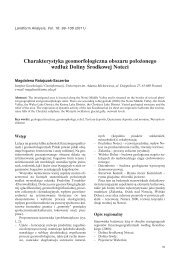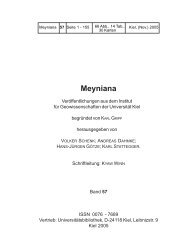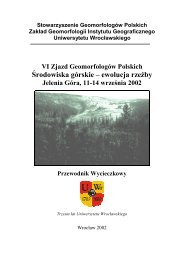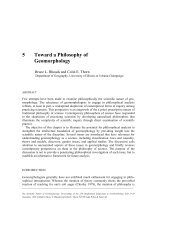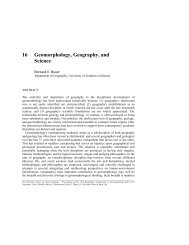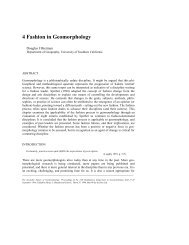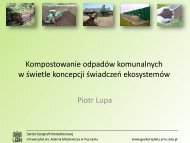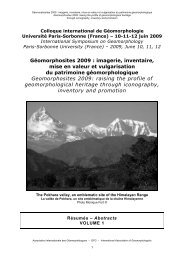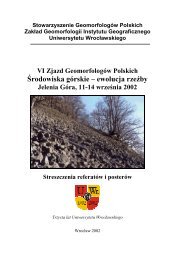Physical Modelling in Fluvial Geomorphology
Physical Modelling in Fluvial Geomorphology
Physical Modelling in Fluvial Geomorphology
Create successful ePaper yourself
Turn your PDF publications into a flip-book with our unique Google optimized e-Paper software.
PHYSICAL MODELLING IN FLUVIAL GEOMORPHOLOGY 223<br />
Figure 9.1 Schematic view of the balance between model specificity and spatial/temporal scales for<br />
different modell<strong>in</strong>g techniques. There is an overall decrease <strong>in</strong> the replication of prototype<br />
characteristics from 1:1 models through Froude scale models (FSMs), distorted scale models, to<br />
analogue models. It should, however, be noted that the modell<strong>in</strong>g of a s<strong>in</strong>gle parameter (e.g.<br />
sediment transport) with<strong>in</strong> a distorted scale model can be more accurate than <strong>in</strong> an FSM. The<br />
spac<strong>in</strong>g of the boxes is schematic, but illustrates two key po<strong>in</strong>ts. First, there is a significant decrease<br />
<strong>in</strong> replicability when mov<strong>in</strong>g from 1:1 to scaled models, and from scaled to analogue models. In<br />
contrast, the transition from FSM to distorted scale models is associated with a smaller loss of model<br />
replicability. Secondly, the chosen spatial and temporal scales for the 1:1, FSM and distorted models<br />
illustrate the relative size at which the modell<strong>in</strong>g techniques are generally used<br />
Early attempts to model fluvial and coastal processes <strong>in</strong>clude the pioneer<strong>in</strong>g work of<br />
Fargue (reported <strong>in</strong> Zwamborn 1967), Thomson (1879), Reynolds (1887) and Gilbert<br />
(1914, 1917). Although Fargue and Reynolds scaled some key controll<strong>in</strong>g variables (e.g.<br />
the horizontal and vertical distance and tidal period by Reynolds), it was not until the<br />
development of dimensional analysis by Buck<strong>in</strong>gham (1915) that scale modell<strong>in</strong>g<br />
techniques <strong>in</strong> eng<strong>in</strong>eer<strong>in</strong>g were widely adopted (e.g. ASCE 1942; Murphy 1950). S<strong>in</strong>ce<br />
these two benchmark publications, numerous physical modell<strong>in</strong>g texts have been<br />
published <strong>in</strong>clud<strong>in</strong>g the <strong>in</strong>fluential works of Yal<strong>in</strong> (1971) on scal<strong>in</strong>g theory, Franco (1978)<br />
and Shen (1991) on movable-bed modell<strong>in</strong>g, and Schumm et al. (1987) on a range of<br />
analogue modell<strong>in</strong>g techniques.<br />
It is now widely accepted across a range of discipl<strong>in</strong>es that physical modell<strong>in</strong>g offers a<br />
number of advantages to the scientist <strong>in</strong>terested <strong>in</strong> a number of landscape evolution<br />
processes (see Hooke 1968; Mosley and Zimpfer 1978; Ashmore 1982; Warburton and<br />
Davies, <strong>in</strong> press). <strong>Physical</strong> models have been used successfully to <strong>in</strong>vestigate various<br />
issues <strong>in</strong> fluvial geomorphology over a range of scales, <strong>in</strong>clud<strong>in</strong>g:<br />
1. Confluence morphology (e.g. Mosley 1976; Ashmore and Parker 1983; Best 1988;<br />
Ashmore 1993);<br />
2. <strong>Fluvial</strong> sediment transport (e.g. Ashmore 1988, 1991a; Ashworth et al. 1992a; Hoey<br />
and Sutherland 1991; Young and Davies 1991; Warburton and Davies 1994a);



